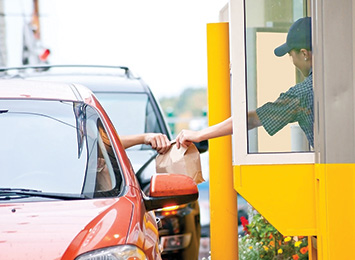 We’re tired of being stuck at home during the pandemic and with many indoor dining establishments closed or with limiting seating, the drive-through lines at fast food places are usually very long.
We’re tired of being stuck at home during the pandemic and with many indoor dining establishments closed or with limiting seating, the drive-through lines at fast food places are usually very long.
But is it safe to eat takeout food? Should you be worried about eating food prepared by someone else during this time?
The good news is that there is currently no evidence of any transmission of the virus through food. Restaurant kitchens can be one of the safest places in this coronavirus outbreak because they already practice strict hygiene protocols to avoid food-borne illness, said Paula Cannon, a professor of molecular microbiology and immunology at Keck School of Medicine of the University of Southern California, in Los Angeles.
What if someone who has the virus is cooking and they cough in the food? What happens to the virus that makes it nontransferable?
What scientists know about SARS-CoV-2 (the virus that causes COVID-19) is that it’s transmitted via respiratory droplets. That means it needs to get into your respiratory tract to cause infection. In contrast, food-borne viruses are transmitted by the fecal-oral routes – you actually have to eat those particular viruses, like norovirus or hepatitis B, in order to get an infection.
HOW SAFE IS TAKEOUT FOOD OR DELIVERY?
When it comes to food safety, there’s always some level of risk. Based on the current understanding of the transmission of the coronavirus, there’s nothing that really points to food being an important vehicle for transmitting the virus. If someone has an active infection and they cough on the packaging, there is the potential for someone to then touch that packaging and subsequently touch their mucous membranes.
At that point, the virus can enter their respiratory tract, but the risk of that is very low. If you’re getting takeout and are concerned about who is handling that food, the best thing to do is wash your hands before you consume the product. Take the food out of the packaging, put it on a plate and then wash your hands before you eat.
Studies indicate that the virus can live on various surfaces. On plastics it can survive for a couple of days, on cardboard it can live for 24 hours. How concerned should people be about touching food packaging that may be contaminated?
Scientists describe this as a low-risk situation. But again, if handling cardboard or plastic packaging of any kind, you can clean and sanitize counters or tables where the packaging was placed. Make sure that you’re washing your hands and avoiding touching your face as much as possible.
Safe food handling at home
The risk of getting COVID-19 from food you cook yourself or from handling and consuming food from restaurants and takeout or drive-thru meals is thought to be very low. Currently, there is no evidence that food is associated with spreading the virus that causes COVID-19.
Although some people who work in food production and processing facilities have gotten COVID-19, there is no evidence of the virus spreading to consumers through the food or packaging that workers in these facilities may have handled.
FOOD SAFETY IN THE KITCHEN
Use proper food safety practices when handling food and before, during and after preparing or eating food.
It is important to safely handle and continue to cook foods to their recommended cooking temperature to prevent foodborne illness.
DRINKING WATER
The virus that causes COVID-19 has not been found in drinking water. The Environmental Protection Agency regulates water treatment plants to ensure that treated water is safe to drink.
CLEAN SURFACES
Regularly clean kitchen counters and use a disinfectant, following the manufacturer’s directions.
If someone in your home is sick, clean and disinfect “high-touch” surfaces daily. These include handles, kitchen countertops, faucets, light switches, and doorknobs.
PACKAGED FOOD
When unpacking groceries, refrigerate or freeze meat, poultry, eggs, seafood, and other perishables within two hours of purchasing.
Do NOT use disinfectants designed for hard surfaces, such as bleach or ammonia, on food packaged in cardboard or plastic wrap.
(Source: Centers for Disease Control)


